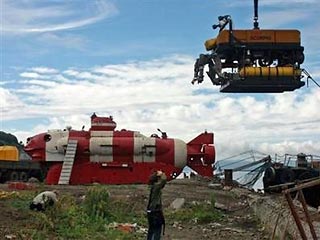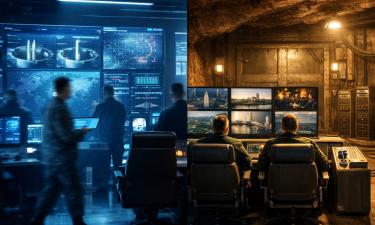Robotic submersible vehicles prove to be indispensable for Russian Navy
There had been no remote-controlled underwater equipment in the Russian Navy before the Kursk disaster
The British robotic rescue vehicle Scorpio was successfully used in the rescue operation to lift the sunken minisubmarine from the Pacific floor in the Far East of Russia. Shortly after the completion of the rescue operation, Russian Defense Minister Sergei Ivanov said the Russian Navy would purchase two rescue vehicles of the above type. Alexander Delyanov, the head of the underwater  equipment department of the company Tetis Pro, presented his views about the capabilities of the up-to-date underwater technologies. The company is contracted by the Russian government to provide equipment and conduct maintenance and personnel training for operations using remote-controlled underwater equipment.
equipment department of the company Tetis Pro, presented his views about the capabilities of the up-to-date underwater technologies. The company is contracted by the Russian government to provide equipment and conduct maintenance and personnel training for operations using remote-controlled underwater equipment.
Q: A considerable amount of modern rescue equipment was purchased for the Russian Navy following two rescue operations on the Kursk. Does the latest incident show that the Navy still does not have enough equipment to handle the crisis?
A: In 2002 the Navy bought 6 inspection remote-controlled vehicle Tiger, two rescue work vehicles Venom, and a lot of other equipment. These days there are five rescue vehicles type Venom in service with the Navy of different countries. Two of them are with the Russian Navy.
Q: Still, the latest incident shows that there is a lack of qualified personnel to operate the Venom. It is also quite clear that the Russian Navy is in need of the rescue equipment type Scorpio. Would you tell us more about the Scorpio and the advantages it has in comparison to similar equipment?
A: Unmanned underwater vehicle of a work class Scorpio was first designed some 20 years ago. A greater mobility is the Scorpio's only advantage. The vehicle weighs 1.5 tons while the weight of the Venom is 3.5 tons plus more than 40 tones of hoisting and control equipment. The Venom's operational capability is greater though the vehicle can only be transported by heavy cargo aircraft e.g. Ruslan. In the meantime, Scorpio can be airlifted quite expeditiously by regular cargo aircraft as shown by the British and U.S. rescue teams in the Kamchatka operation.
Aside from the Scorpio, more than 30 specialists arrived on that fight. The specialists included four shifts of operators, a dozen engineers, specialists in computer equipment, hydroacoustics, hydraulics etc. We have a lot smaller number of the Russian Navy personnel trained to operate the equipment. From my point of view, the following units have properly learned to operate the new equipment: rescue and emergency units at the Northern Fleet, Black Sea Fleet, and the Baltic Fleet. Personnel at the State Research Center for Emergency and Rescue Operations No 40 and the Emergency and Rescue Team No 328 are also well-prepared. Other navy units treat the vehicles as some complex equipment they have to put up with.
Q: Does it take a lot of special training to operate the equipment?
A: Well, I will give you some facts and figures and you will make your own conclusion. Two operators control the Venom simultaneously while a pilot is in charge of the vehicle's seven engines. One operator is responsible for the sonar system which acquires the bearings and measures the distance to an object. The other operator controls the working tools once the visual contact is established (subject to water transparency). The tools include two manipulators, cable cutter, circular and chain saws etc. The second operator keeps an eye for data of the whole control complex emerging on four onboard computers.
Q: The Navy had previously relied on the work of rescue divers and manned underwater vehicles.
A: There had been no remote-controlled underwater equipment in the Russian Navy before the Kursk disaster. Russian specialists gathered information monitoring international media. The Kursk rescue operation was the first time we saw the equipment in action. We watched the Tigers play an essential role the diving operations. They were used for monitoring the situation and delivering tools and equipment required by the divers. We realized that rescue services all over the world use the equipment as a cornerstone of the effective rescue operation. So we followed suit and bought the above equipment. However, you can have it on hand yet fails to work as it should. It took a huge effort to mount the equipment on the existing vessels. Because the vessels are really obsolete, I mean some of them belong to the 19th century while equipment is state-of-the-art and spanking new. We had to carry out complex calculations to ensure that equipment is powered adequately. The equipment consumes an enormous amount of power. Electrical surges have become a commonplace in the Russian Navy, they have a very detrimental impact on the equipment. Changing oil or a light bulb is not part of our job, we are involved in the complex modernization of equipment. We have recently delivered uninterrupted power supply equipment to the fleet including the vessels based in Kamchatka. However, it is easier to keep equipment upgraded than train a certain number of specialists.
Q: Those specialists are usually trained abroad, am I right?
A: Yes, you are. We came up with a proposal to set up a training center for permanent upgrade training of specialists here in Russia, at the State Research Center of Emergency and Rescue Operations No 40. Nowadays it is impossible to deny the fact that Russian specialists have already gained some positive experience in running the equipment. Last month we saw excellent results during the naval exercise in the Northern Fleet.
Technical specifications of remote-controlled underwater rescue vehicles
Venom
Operational submergence depth: 1,500 m
Weight: 3,500 kilograms
Dimensions: 3.3 m (length overboard); 1.7 m (width); 1.9 m (height)
Number of engines: 7
Video cameras: 1 color/ 1 zoomed color/ 1 monochrome
Hydraulic manipulators: 1 seven-stage and 1 five-stage
Laser distance gage: available
Number of lamps: 8
Year designed: 2002
Scorpio
Operational submergence depth: 1,000 m
Weight: 1,500 kilograms
Dimensions: 1.9 m (length overboard); 1.4 m (width); 2.0 m (height)
Number of engines: 5
Video cameras: 1 color/ zoomed color – not available / 1 monochrome
Hydraulic manipulators: 1 seven-stage and 1 five-stage
Laser distance gage: not available
Number of lamps: 4
Year designed: 1986
Tiger
Operational submergence depth: 1,000 m
Weight: 150 kilograms
Dimensions: 1.0 m (length overboard); 0.7 m (width); 0.6 m (height)
Number of engines: 5
Video cameras: 1 color/ zoomed color – not available/ 1 monochrome
Hydraulic manipulators: 1 four-stage (electro-hydraulic)
Laser distance gage: not available
Number of lamps: 4
Year designed: 1998
Subscribe to Pravda.Ru Telegram channel, Facebook, RSS!





